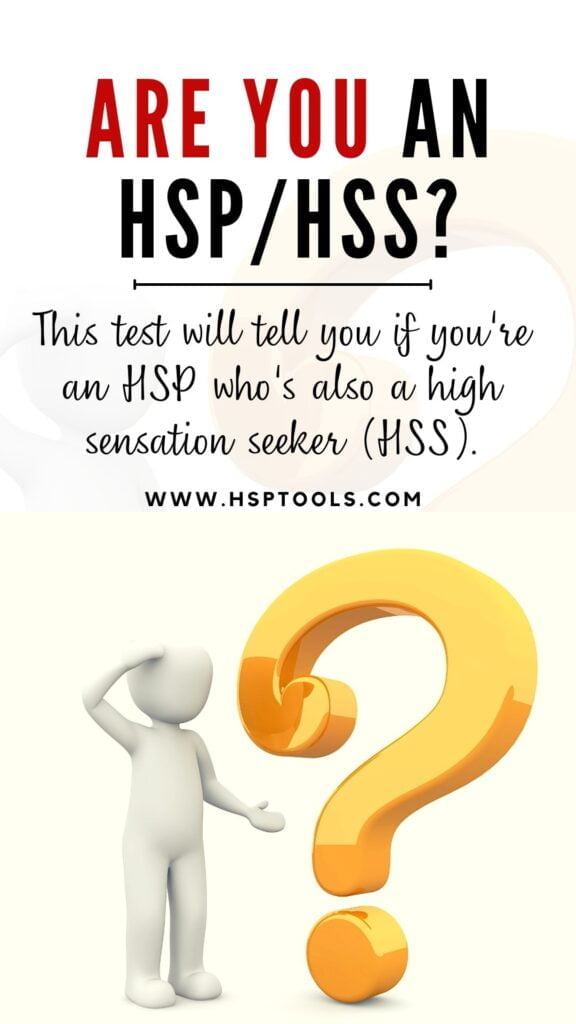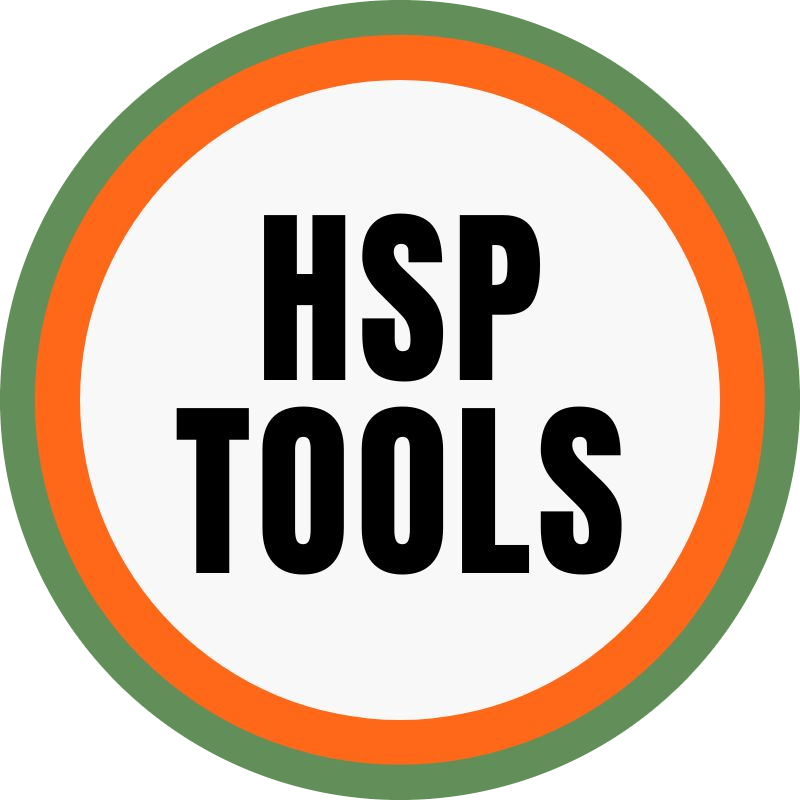It’s almost impossible to believe that a Highly Sensitive Person (HSP), who ranks high on inhibition, can also be a High Sensation Seeker (HSS).
Yet, according to HSP researcher and pioneer Dr. Elaine N. Aron, this is the reality for at least 50% of HSPs.
So in this post, we’d like to share what we’ve learned so far about high sensation seeking. And then share the high sensation seeker test with you so you can confirm if you’re an HSP who’s also an HSS (HSP/HSS).
And also learn what it means to be an HSP/HSS.
- What does it mean to be a High Sensation Seeker?
- What is sensation-seeking a symptom of?
- Is Sensation Seeking Genetic?
- What are the 4 Components of Sensation Seeking?
- Sensation Seeking Vs High Sensation Seeking: What’s the Difference?
- The High Sensation Seeker Test for HSPs
- What Does it Mean to Be an HSP/HSS?
- Final Thoughts on Being an HSP/HSS
- Related Posts You Might Like
What does it mean to be a High Sensation Seeker?
As the name suggests, a high sensation seeker is someone who’s always on the lookout for new and exciting experiences.
This person scores high on the sensation-seeking trait, otherwise known as novelty-seeking, excitement-seeking, or thrill-seeking.
What is sensation-seeking a symptom of?
Sensation-seeking isn’t a symptom. It’s a personality trait describing people who like to go after new, different and exciting sensations.
Or people who will go out of their way to experience something different and intense.
Is Sensation Seeking Genetic?
The short answer is Yes.
And the specific answer is this:
According to research published in this PMC article on NCBI, “the predominant influence on the change in sensation seeking is genetic factors.”
In fact, here’s an exact quote from the article:
Behavioral genetic analyses of a subset of 2,562 sibling pairs indicated that there were substantial genetic influences on both initial levels of sensation seeking and change in sensation seeking during early adolescence, with over 80% of individual differences in change due to genetic factors.
So yes, sensation seeking is substantially genetic.
What are the 4 Components of Sensation Seeking?
The original (or traditional) concept of Sensation Seeking as identified by Marvin Zuckerman shows the trait as having 4 distinct parts. These include:
- Thrill and Adventure Seeking – Describes a person’s desire to participate in risky physical and sporty activities. Such as bungee jumping, sky diving, e.t.c.
- Experience Seeking – Describes the desire to explore and participate in new experiences through sense, travel and lifestyle. Such as seeing new towns, trying different foods, learning a language, exploring cultures, etc.
- Disinhibition – Describes a person’s desire for impulsivity or tendencies to act without regard for long-term consequences. Especially with social drinking, partying, variety in sexual partners & experiences, etc.
- Boredom Susceptibility – Explains a person’s preference for unpredictability and non-routine activities. Describes someone who’s easily bored and who longs for spontaneous activities and friends.

Sensation Seeking Vs High Sensation Seeking: What’s the Difference?
As with many personality traits, sensation seeking is on a spectrum and normally measured on a scale. There are those who score low (referred to as low sensation seekers), and those who score high (referred to as high sensation seekers). And this is where the difference comes in.
But also, there’s another difference important to HSPs you need to take note of.
Sensation Seeking has always been linked (and sometimes interchanged) with impulsivity and risk-taking. In fact, if you were to take the original Sensation Seeking Test by Marvin Zuckerman, you’d likely feel more lost as a highly sensitive person with high sensation-seeking tendencies.
And here’s why:
The scale has 40 statements in form of choices. It requires you to select one option over the other. And while that in itself isn’t a problem, the wording of the statements is. To an HSP, this is a very big deal.
The scale requires you to be one thing or the other. There’s no in-between or a checklist to check what you identify with and leave out what you don’t. And we found this to be quite restricting and to be honest, annoying.
That’s why if you’re an HSP wanting to take the high sensation-seeking test, we highly recommend you take this HSS test by Dr. Elaine Aron.
The wording is sensitive to HSPs and it comes with a further explanation to help you understand what it means to be both HSP and HSS.
The High Sensation Seeker Test for HSPs
Now that you understand what it means to be a high sensation seeker, and the difference between high sensation seeking and sensation seeking, let’s get to the test.
Dr. Elaine N. Aron has created 3 tests in total to help highly sensitive people (HSPs), highly sensitive children (HSCs), and high sensation seekers (HSSs) put a name to their “weird” tendencies.
These tests aren’t provided as a way to diagnose or exclude a diagnosis of a condition. So have this fact in mind as you learn more and take the high sensation seeker test.
The test has a total of 20 statements that you’re required to check if true or somewhat true, and leave unchecked if not very true or not true at all. And if at the end of the test your score is 11 or more, you’re probably a high sensation seeker.
What Does it Mean to Be an HSP/HSS?
If your score on the high sensation seeker test is on the higher side, you may be wondering: what now?
Well, there’s a lot of good that comes with being an HSP/HSS. And there’s also a lot of bad.
The good part is that your HSP side allows you to explore all the options before plunging deep into a potentially risky experience. It also allows you to fully enjoy a new experience with an intensity that isn’t possible with someone who’s only HSS.
And on the other side, your HSS side allows you to go out and explore new opportunities that you would otherwise be opposed to as an HSP.
As for the bad part, your HSS side can cause you unnecessary overwhelm, exhaustion, and even frustration. This is because it’s the part of you that says yes to novel experiences and spontaneity. And it’s the part of you that wants to go out and experience things your HSP side finds overwhelming.
So there’s a need to find a balance between these two sides. Otherwise, you’ll always be in a constant argument with yourself. Because there are two parts of you that desire to be heard and you can’t split yourself into two.
Final Thoughts on Being an HSP/HSS
Being an HSP who’s still learning to embrace their high sensitivity is already hard enough. And if the high sensation seeker test confirms you’re an HSS, things are about to get even harder.
Imagine trying to embrace being an HSP/HSS and learning to find a balance between the two. It’s not easy.
In fact, it’s outright difficult.
You feel bad for choosing to stay in the comfort of your own space. And you feel bad for choosing to go out and explore what the world has to offer.
You’re always in an argument with yourself, and the HSS side tends to always win, leaving you drained and exhausted.
But just because something is difficult doesn’t mean it can’t get easier or done.
With a little help and the right tools, you can learn to embrace both parts and find a way to live without guilt. And Dr. Elaine N. Aron proposes the following:
- Look at your HSP/HSS combo as a package deal – What you don’t like about the other is the flip side of what you do like.
- Grieve what cannot be – This is all about acceptance. When you accept that you’re going to be limited in the experiences you can be part of as an HSS. And also accept that you’re going to be over-aroused and overwhelmed as an HSP. Then you can learn to live with both of these.
- Get creative. Accepting what can be and what cannot be is usually the first step towards growth. Not only as an HSP but also in improving life in general. So this is where you plan to live fully and happily as an HSP and HSS.
- Use each part to bring YOU what you want. According to Dr. Aron, a part of you isn’t HSP or HSS. It’s just YOU with your talents, values and goals. And you can use the parts that identify as HSP and HSS to feed YOU.
Learn more about this on Dr. Aron’s website.




